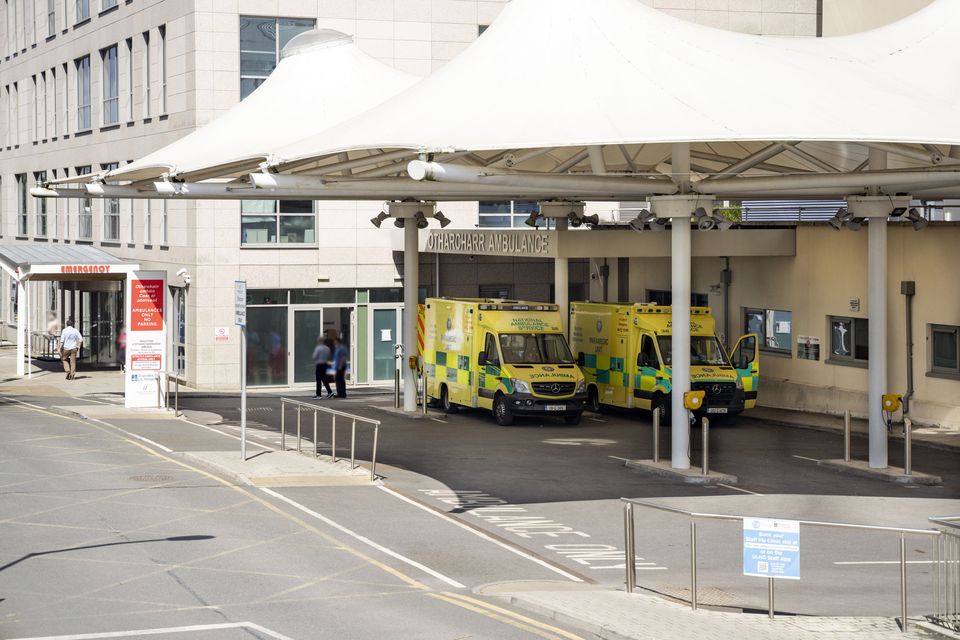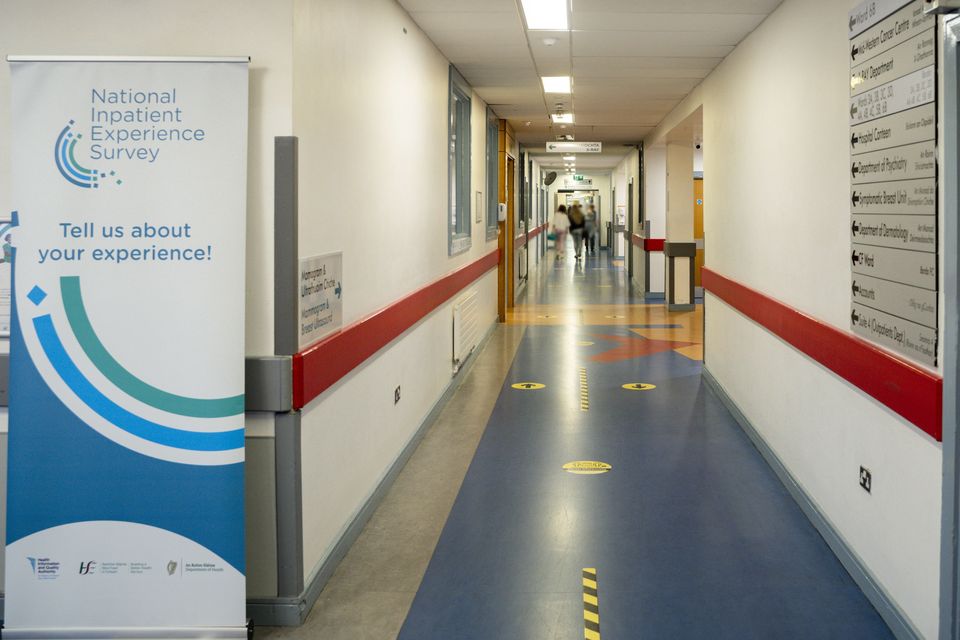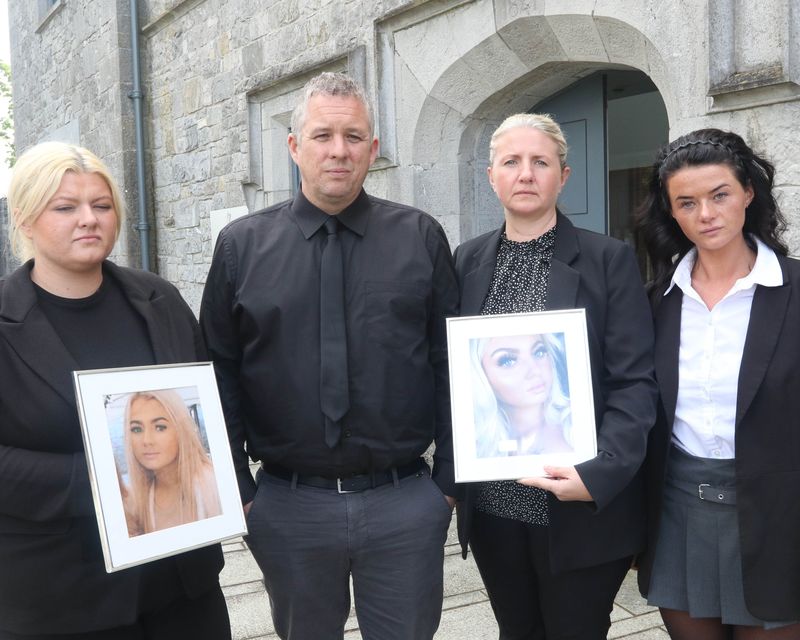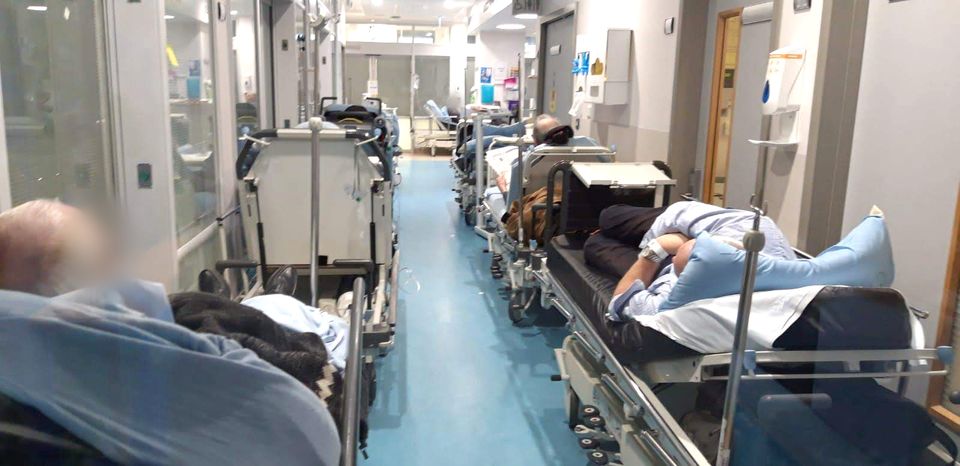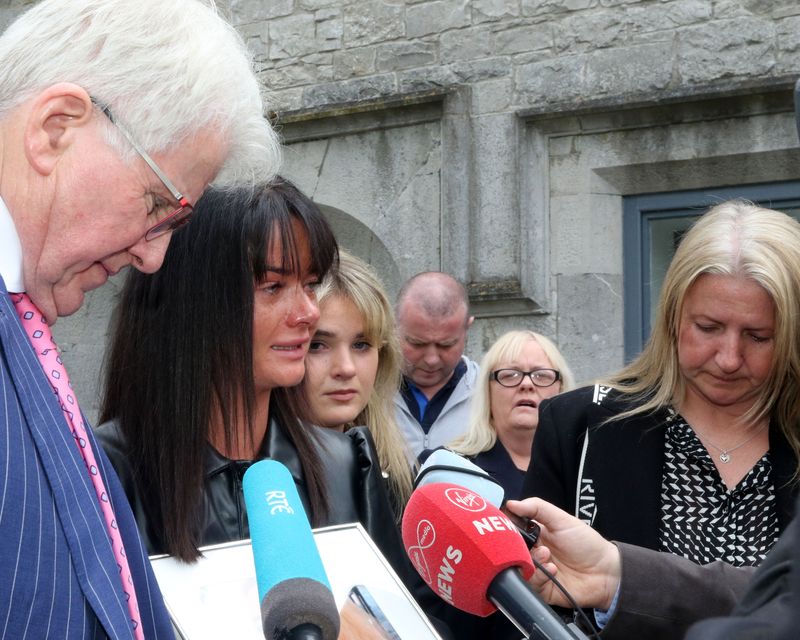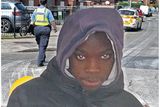‘Aoife died a horrible death and suffered all night; people need to know that’ – Mother’s anguish after inquest
Teenager Aoife Johnston, who died in the UHL emergency department in 2022, was in a chaotic and overwhelmed ‘war zone’ where basic measures might have saved her
The family of Aoife Johnston responds to inquest verdict
Over four days of harrowing testimony at Aoife Johnston’s inquest, the most wrenching described her final hours on a trolley at University Hospital Limerick’s (UHL) teeming “death-trap” emergency department as her life ebbed away before her parents’ eyes. She did not go gentle into that good night.
On Saturday morning, December 17, 2022 in Limerick, Aoife Johnston (16) woke up at home in Shannon, Co Clare, just as the school holidays were beginning, “in great form”, said her father, James.
She had breakfast and then went for a shower. She spent a couple of hours in her bedroom, then came downstairs. She had vomited and felt unwell.
Her parents took her to Shannon Doc, the out-of-hours GP service, who noted sepsis and dehydration and urged them to go to the emergency department.
She arrived at 5.40pm, alert but weak, witnesses said. She was triaged at 7.15pm by a nurse who noted “Query sepsis” and left Aoife to wait in a wheelchair in Zone A to be seen by a doctor.
'I never got to say goodbye': Aoife Johnston's sister Meagan speaks outside court after the teenager's inquest
Her mother looked at the “huge number of the trolleys” and said: “Look, she’s really unwell, you’re not leaving us here, are you?”
Aoife was moved into what appeared to be a storage room full of PPE. Her parents pushed two chairs together to make a bed for her as there was no trolley.
Hours passed. Aoife did not get better. She was “violently vomiting” green liquid. She had a red blotch on the corner of her eye and a continually raised temperature, said her mother, Carol.
“I was up and down to the nurses all night pleading with them to help my daughter who was screaming in pain in her head and her right leg,” she said.
Her father heard other patients on trolleys outside the room urging staff to respond.
Nurse Ciara McCarthy tried three times to persuade doctors to review Aoife’s condition, but they were too busy
“At one point a man said, ‘Is someone not going to go into that girl?’”
The only nurse in Zone A – Ciara McCarthy – was looking after 50 patients waiting to be assessed by a doctor who had been deployed to the resuscitation room.
Nurse McCarthy checked Aoife at 11.50pm, 1.40pm, 2.30am and 4am, noting her consistently raised temperature and low blood pressure.
She tried three times to persuade doctors to review her, but they were too busy and prescribed fluids and pain relief to ease her symptoms. She said she did not know that Aoife was a possible sepsis patient — there was no sepsis form on her chart.
At 5.45am, Nurse McCarthy asked Dr Leandri Card, a senior house officer, to see Aoife next because her mother was increasingly concerned, and she agreed, even though other patients were ahead of her.
Dr Card found Aoife was “warm to the touch”, complaining of severe body pains.
“She was fully conversing with me and fully conscious, but seemed very anxious,” she said. Aoife said she had had a sore throat earlier in the week, but it had cleared up.
The emergency department at UHL. Photo: Don Moloney
Her parents stood by her trolley, the doctor prescribed antibiotics to cover the possibility of meningitis and referred Aoife to the medical team to be assessed for admission to hospital.
Dr Card said she did not expect Aoife to deteriorate as rapidly as she did. The doctor moved on to other emergency patients and Aoife did not get the antibiotic until 7.15am, still in her cubicle in the crowded ED.
Her condition had declined even further. Her father went to the nurses’ station, where he said he saw 12 nurses.
“I roared at them to help my daughter,” he said.
Read more
By then, Aoife could no longer communicate.
Nurse McCarthy rushed to Aoife’s cubicle at 8am. By then, the teenager was “at the bottom of the trolley, distressed, tearful and agitated”.
Aoife’s whole body was flailing. Her “limbs were moving involuntarily”, her mother said
The nurse asked Aoife’s father to help her reposition back on the trolley.
“Her parents were distressed, her mother was crying and her dad was very upset and verbalising concerns about Aoife,” she said.
She took Aoife’s vital signs and ran out to get a doctor, and when she returned two minutes later, Aoife had become “unresponsive” and was “not engaging in coherent conversation when asked questions”.
On her own accord, the nurse said, she immediately moved Aoife to the resuscitation area with the help of two other nurses.
At his stage, her whole body was flailing. Her “limbs were moving involuntarily”, her mother said. Mrs Johnston held down her daughter’s arms and her father held legs so their child could be treated.
Aoife’s parents were told she was being put into an induced coma because of the swelling on her brain and that this would “allow her body to relax”.
Aoife was transferred to ICU later that morning. Her parents were told there was nothing that could be done to save her. She died on December 19 at 3.31pm.
Aoife Johnston's mother Carol Kilmallock Coroners Court. Photo: Brendan Gleeson
On Thursday, Mrs Johnston stood outside the courthouse in Kilmallock, Co Limerick, flanked by her husband and daughters Meagan and Kate and uttered words no mother should have to.
“Aoife had a horrible death and she suffered all night. People need to know that.”
Earlier, Limerick coroner John McNamara delivered a verdict of medical misadventure in the death of Aoife Johnston from meningitis after contracting sepsis. The coroner acknowledged the “breakdown in communication throughout her care” as well as “systemic failings” and “missed opportunities”.
For four distressing days, the Johnston family relived the loss of Aoife as almost 30 witnesses contributed to the narrative of her final hours in casualty at UHL.
Aoife’s family may have expected to hear clear and undisputed facts in the chain of events that culminated in her death, but some facts were challenged and some accounts were forgotten or disputed.
At one point during the inquest, the family solicitor and senior counsel Damien Tansey told the coroner of the Johnston family’s concerns over “passing the buck”.
As well as charting Aoife’s avoidable death, the inquest is a window into the chaotic dysfunction at the heart of the most persistently and chronically overcrowded emergency department in the State.
Nurse Katherine Skelly described it as a “war zone”, with trolleys back-to-back lining either side of the corridor
The scene was set by Katherine Skelly, the clinical nurse manager in charge of the department on the night of Aoife’s attendance.
Nurse Skelly came on night duty at 8pm, and while overcrowding was nothing new to her, that night she saw an unfolding crisis.
She described it as a “war zone”, with trolleys back-to-back lining either side of the corridor, blocking the entrance to toilets and cubicles.
Every available floor space was taken up with patients lying or sitting in every nook and cranny. The icy weather conditions brought a deluge of patients presenting due to falls and accidents.
Fourteen patients crowded into the resuscitation room, reserved for life-threatening or potentially life-threatening cases and designed to accommodate seven.
She counted 67 category-two patients who, like Aoife, were seriously ill and ought to have been seen in 10 to 15 minutes.
There were 15 nurses on duty that night, down five. Given the number of patients, Nurse Skelly estimated they would have needed 30 nurses.
At 9.45pm, she said she phoned the assistant director of nursing on duty that night, Patricia Donovan.
She recalled clearly her words: “I am dealing with a major emergency, we need help, can you come down?”
Nurse Donovan advised Nurse Skelly to ask the two consultants on call to come in because of the number of category-two patients waiting to be seen.
Nurse Donovan in turn spoke to Fiona Steed, then a general manager who was the “executive on call”.
A file photograph inside University Hospital Limerick. Photo: Don Moloney
Ms Steed, who was not on site, said the words “major emergency” were never used in her phone conversation with the assistant director of nursing.
She advised implementing a surge policy, to reopen some units and to transfer admitted patients on trolleys from the emergency department to wards.
The measure could have removed up to 40 patients from the overcrowded emergency department that night, Ms Steed said.
She “wrongly” assumed her advice would be followed, but it was only partially followed.
Nurse Skelly, at the coalface, said she never received Ms Steed’s advice and was still phoning management at 3.45am looking for “trolleys to go on wards”
Two nursing managers testified that the advice was passed on and discussed with a bed manager, but suitable patients could not be found.
Nurse Skelly, at the coalface, said she never received Ms Steed’s advice and was still phoning management at 3.45am looking for “trolleys to go on wards”.
To add to the pressure, only one of the two on-call consultants responded to the request to attend the emergency department that night. Nurse Skelly recalled a short conversation with consultant Dr Jim Gray, filling him in on the volume and acuity of patients.
In his evidence, Dr Gray said he said he could not attend as he had been in the emergency department until 3pm and had to be at work again at 8am. Consultants were required to attend casualty for specific cases or a major emergency, but not for overcrowding, he said.
“Had I known that there was a 16-year-old child who entered the ED in septic shock, a category-two patient who couldn’t get into the resus room... the system failed her... the ED failed her. If I had known there was a patient like that in the department, I would have gone in,” he said, questioned by Damien Tansey.
“The problem was, Mr Tansey, I was not asked to come in about a specific case.”
Kate, James, Carol and Meagan Johnston outside Kilmallock Courthouse last week. Photo: Brendan Gleeson
Even if he had attended, such was the chaos that “an extra person like a consultant may not have made the difference you think it would have made”.
Ms Steed said she escalated Dr Gray’s decision not to present at the department to the clinical director that night, but he did not reply to her text until the following afternoon.
It was notable that several witnesses said UHL management made plans to accommodate staff in the icy weather, but apparently not for the surge of trauma patients it would bring.
Ultimately, the only thing that could have saved Aoife Johnston as infection advanced as she lay on a hospital trolley was an antibiotic.
Doctor after doctor testified that the risk of death increased with every passing hour, and in all likelihood Aoife would have survived had she received antibiotics earlier.
Mr Tansey highlighted the “over-concentration” in the resuscitation room, where the two most senior registrars tended to fracture patients, while outside, 67 category-two patients waited to be seen.
Dr Mohammed Hassan and Dr Muneeb Shahid were the two most senior doctors on the floor on that night shift.
Neither could recall nurses asking them to assess Aoife that night. Dr Hassan doubted it ever happened.
Dr Muneeb said he found no markers of sepsis when a nurse brought her chart to his attention at 11pm; he mistakenly said he believed Aoife had been “re-triaged” as a less urgent category-three patient — an error the UHL legal team corrected for the record.
Aoife Johnston
He said he was called to Aoife’s cubicle at 8am and checked her vital signs and found them to be normal. Aoife’s family and friends in the public gallery were aghast, shaking their heads in disbelief.
Mr Tansey pointed out that at 8am, Aoife was incoherent, slumped on the trolley and dying.
Throughout the inquest, Mr Tansey highlighted failure after failure in Aoife’s care, and poor practices such as prescriptions written “like confetti” by overwhelmed doctors for patients they had not assessed.
He elicited from Dr Jim Gray a damning indictment of UHL’s emergency department as a “death trap” and “grossly dangerous” to point where Aoife “had no chance”. The department was a “dysfunctional environment” and “always overcrowded”, he said.
The inquest closes one chapter in the continuing investigations into Aoife’s death.
An inquiry is under way by retired Chief Justice Frank Clarke, and following the inquest verdict of medical misadventure there have been calls for a public inquiry.
“There will be further engagement with Frank Clarke in light of some of the significant developments that happened during the course of the inquest,” said Mr Tansey this weekend.
“We will be furnishing, in support of that, the relevant sections of the transcript of the inquest.
“Other matters that were not canvassed during the course of the inquest but which have come to light will also be brought to his attention.”
Patients on trolleys in University Hospital Limerick
The ‘forces’ in UHL at odds over trolleys on wards
Aoife Johnston’s inquest heard how the practice of placing trolleys on wards to free up space in casualty had recently been discouraged at UHL.
A&E consultant Dr Jim Gray said a new emergency department was built in 2017 to accommodate increased demand, but the hospital did not get more beds for the extra patients.
For every 100 emergency department patients, 30 are admitted, he said. When there are no extra beds to take those admitted patients, they stay on trolleys in casualty.
It used to be the case that those patients were placed on wards, which was not ideal but spread the risk, he Dr Gray added. The practice “seemed to stop” in 2022 and there has “been a struggle to reinstate it”.
Another witness said the practice was “recently discouraged”, apparently after a HSE inspection in 2022 that deemed it unsafe.
This led solicitor Damien Tansey to question the conflicting “forces” at play in UHL — one supporting the practice of trolleys on wards, and a “counter-force” that did not.
‘Aoife was a happy, good kid. She was our baby’, says heartbroken mother
There was so much more to Aoife than “the girl who died on the trolley”, her mother Carol said after the inquest verdict was delivered last week. “That is how Aoife is known. In time, when me and James can talk to people properly, they will get to know the real Aoife and the lovely 16-year-old girl she was. She was our baby who we loved very, very much,” she said. Aoife was in her Leaving Cert year at school and was described during the inquest as a beautiful girl who loved fashion and make-up. One nurse recalled how she chatted about visiting her boyfriend’s house on Christmas Eve, even though she was very ill. Her family described a vivacious, bubbly teenager, the youngest in the family, behind Meagan and Kate.
Meagan Johnston speaks to the media outside Kilmallock courthouse. Photo: Brendan Gleeson
“Her sisters loved her very, very much. She was a happy, easygoing girl — happy-go-lucky, went to school, got summer jobs and she was never any hassle to me or her Dad — she was a good kid,” Carol said. “As James would say, a cool kid. Aoife came on holidays with us every year — she would say ‘no, no’ because she was too cool but she loved every minute of it.” Her sister Meagan cried as she recalled “the best sister ever”. She said: “It kills me all the time that I never got to say goodbye to her. “I never got to see my sister complete her Leaving Cert, I never got to see her do her graduation, I never saw my sister moving on to the next chapter with her boyfriend. He is left heartbroken. “She was an amazing person and I will cherish the memories of her forever and ever. I am so sorry Aoife for what happened to you. But my Mum and Dad did everything they possibly could for her.” Carol Johnston said they brought Aoife to hospital, thinking that she would be looked after. “We told her she was in the best place. We told her to get some rest and that the doctors would be here soon. But the doctors never came. “We welcome the verdict and the apology but that is not going to change anything. “Aoife is gone now. That is what we have to live with. I don’t know what else to say.”
Read more
Join the Irish Independent WhatsApp channel
Stay up to date with all the latest news
